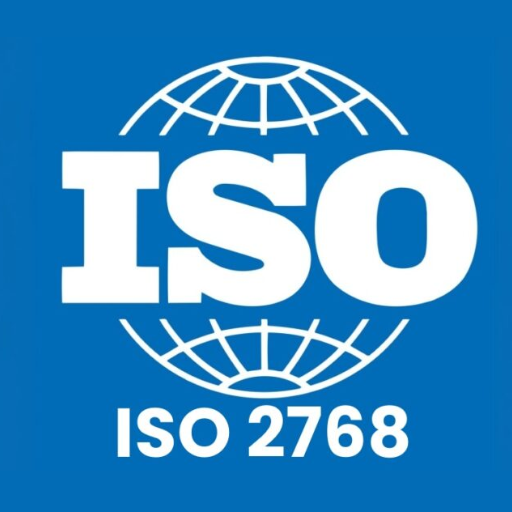In the world of CNC machining, where everything is measured precisely and exact tolerance standards are important to produce accurate and quality parts. This international standard provided in ISO 2768 for such tolerances helps manufacturers ensure uniformity and reliability in their processes. These general tolerances are valid for linear dimensions, angular dimensions and geometrical tolerances covering parts having no specific tolerances mentioned on the individual drawings. Understanding ISO 2768 can enable manufacturers to better understand complicated tolerance standards leading to increased effectiveness, reduced mistakes and overall elevation of product value. Coming up next is a blog that will try to expound on what ISO 2768 entails as far as its framework, importance; relevance; effect and application in CNC Machining are concerned.
What is ISO 2768 and Why is it Important?

Image source: https://at-machining.com/
The ISO 2768 standard is an international standard developed to provide precise guidelines for general tolerances in the manufacturing industry, specifically for components that do not bear individually specified tolerances on their drawings. This is important because it provides clear-cut standards for allowable deviations in dimensions and geometries, thus ensuring uniformity and dependability in the process of production. By following the guidelines of ISO 2768, manufacturers can have better control over their quality, minimize chances of mistakes and improve the efficiency with which they handle their operations resulting into high quality parts and products.
Understanding ISO 2768 Standards
The ISO 2768 can be divided into two main parts namely; ISO 2768-1 – general tolerances for linear and angular dimensions without individual tolerance indications and ISO 2768-2 – geometrical tolerances for features without individual tolerance indications. These standards classify tolerances within four grades namely; fine (f), medium (m), coarse (c) and very coarse (v) thereby allowing manufacturers to apply appropriate precision levels according to specific requirements of a part being manufactured. These classifications make sure that manufacturers meet necessary quality as well as functional requirements while at the same time rationalizing manufacturing processes so as to reduce costs. These allowances facilitate better rapport between designers and fabricators culminating in more dependable items.
Importance of Tolerance Standards in CNC Machining
Tolerance standards are significant in CNC machining because they guarantee that parts manufactured are within defined limits and this ensures uniformity and exactness. Observance of these tolerance standards reduces losses, shortens rework, and improves the overall quality of the end product. Also, tolerance standards enable clear communication between designers and manufacturers to ensure that these parts fit properly into their intended final assemblies. Furthermore, keeping strict tolerances contributes to getting more accurate and high-performing products necessary for aerospace, automobile, and medical devices sectors among others. Ultimately, implementing effective tolerance standards in CNC operations improves productivity levels through reduced lead times.
Benefits of ISO 2768 Certification
ISO 2768 is an important certification as it enhances precision and guarantees quality assurance. It helps in removing trade barriers by adhering to international specifications which allow components to be easily integrated across various systems and industries worldwide. This lets down errors and inconsistencies leading to lower production costs and higher levels of customer satisfaction. Besides this fact, ISO 2768 promotes better communication between designers and manufacturers through end up with a better understanding of one another’s needs resulting into more reliable production processes. By applying ISO 2768 requirements companies can show that they are committed towards quality as well as continual improvement thus gaining a competitive advantage over other businesses on the market space.
Breaking Down ISO 2768-1: General Tolerances

ISO 2768-1 is an international standard for mechanical engineering that sets out rules for general tolerances to ensure good fits of parts without the need for individual tolerance specifications on each dimension. It deals with linear dimensions (for example, lengths, widths and heights), angular dimensions and shapes. Usually ISO 2768-1 is divided into four tolerance classes: fine (f), medium (m), coarse (c) and very coarse (v) that enable manufacturers to select the required precision level depending on the needs of a particular application. The use of these standardised tolerances simplifies production, facilitates interchangeability and reduces assembly problems.
Overview of ISO 2768-1
ISO 2768-1 is part of ISO 2768 standards series which gives directives on general tolerances in mechanical engineering in order to make sure that parts are fitting well without having to write down any specifications per dimension. It defines acceptable deviations from standard linear and angular measurements arising from manufacture processes. The standard has been grouped into four different classes of tolerance: Fine(f), Medium(m), Coarse(c) and Very Coarse(v) enabling manufacturers to choose appropriate levels of precision as required by their products. Adoption of ISO 2768-1 helps reduce manufacturing time, increase component compatibility, lower assembly issues hence leading to overall high product quality all with less cost involved.
General Tolerances for Linear and Angular Dimensions
The ISO 2768-1 standard defines specific tolerances for linear as well as angular dimensions of various classes, which assure compatibility and fit between parts. For linear dimensions, these tolerances apply to lengths, widths, and heights of parts, differentiated by the four tolerance classes (fine, medium, coarse, and very coarse). The size limits are given for different ranges of nominal sizes so that makers can satisfy certain precision requirements without going into specific detail on the blueprint with individual tolerances.
Similarly, such tolerance classes regulate angular dimensions in terms of controlling angles between features on components. The ISO 2768-1 standard makes manufacturing easier by setting norms for allowable variances and maximum permissible values for items produced. Henceforth production becomes less complicated as manufacturers do not need to carry out too many detailed inspections resulting in high quality standards required in component parts.
Key Features of ISO 2768-1 Certification
ISO 2768-1 specifies several vital aspects that facilitate manufacturing and quality control procedures. Firstly, it deals with standardized general tolerances for linear and angular dimensions so as to avoid the need of making individual tolerance indications on technical drawings. This means a lot for production efficiency, simplicity reduction and lessening mistakes risks in fabrication. Moreover, general tolerances under ISO 2768-1 are divided into four classes including fine (f), medium (m), coarse (c) and very coarse (v) for manufacturers to select precision levels necessary in certain applications. Such adjustability is useful in striking a balance between accuracy and production expense. Companies can interchange their parts better because of this certification, which will make components from different suppliers be integrated without any difficulties leading to improved product quality at the end. With ISO 2768-1 conformity, businesses can streamline their production cycles; improve part reliability while reducing non-conformance costs as well as rework expenses.
Exploring ISO 2768-2: Geometrical Tolerances

Geometrical tolerances are dealt with by ISO 2768-2 that is essential for defining the shape, orientation and position of features in manufactured parts. Geometric tolerances, unlike linear and angular dimensions covered under ISO 2768-1, discuss concepts such as flatness, perpendicularity, symmetry and concentricity. This point also assumes that ensuring that parts fit and function together as intended promotes higher assembly precision and operational efficiency. Different tolerance classes (H,K,L for geometrical tolerances) helps manufacturers choose quality levels which match their production capabilities and application requirements. Consistency in applying to ISO 2768-2 relates to minimal manufacturing defects, complexity of components’ interchangeability, minimizing manufacturing defects and improving on the consistency as well as interchangeability of complex components.
Understanding ISO 2768-2 Specifications
To ensure the proper functioning and assembly of machine parts, it is vital to understand the specific elements in ISO 2768-2 concerning geometrical tolerances. These geometrical tolerances are divided into different sections by the norm such as form, orientation, location and run-out. Every category has its own limits and conditions to be followed by manufacturers when maintaining shape and orientation requirements such as flatness, perpendicularity and symmetry. In practice, choosing a suitable tolerance class (H, K or L) for given manufacturing context ensures that components meet design specifications and functional requirements. Fewer defects; more consistency; interchangeability among different suppliers are some of the benefits of adhering to these specifications in manufacturing.components
Geometrical Tolerances for Features
The geometrical tolerances for features are of utmost importance as they determine the degree to which individual parts and assemblies may differ in their geometry. These tolerances enable parts to come together despite slight variations that occur during manufacturing. They include:
- Form Tolerances: These control the shape of individual features and comprise such characteristics as straightness, flatness, circularity, cylindricity.
- Orientation Tolerances: These govern the tilt or alignment of a part’s feature with respect to another. An example is an angularity involved, perpendicularity versus parallelism.
- Location Tolerances: These specify positioning a feature exactly with reference to a point or axis including positional accuracy, concentricity and symmetry.
- Run-out Tolerances: These restrict both form and location by placing boundaries on how much a feature can vary when the part is rotated around any datum axis; these include circular run-out and total run-out.
Following defined geometrical tolerances strictly ensures that manufacturers have better consistency and less defects thereby making possible interchangeability of components from different suppliers.
How ISO 2768-2 Complements ISO 2768-1
ISO 2768-2 is an extension of ISO 2768-1, which has a detailed specification for additional geometrical tolerances not covered in ISO 2768-1. It defines the basic dimensional requirements that all linear and angular dimensions must meet and provides more details on form, orientation, location and run-out among other parameters. Taken together, these standards give a complete framework that addresses both dimensional and geometrical aspects in production processes. In this way, the company guarantees quality through consistent measures that will enhance its products’ fitments. This unified method boosts precision, allows the use of interchangeable parts and makes it easier to design new components with ease because everything is based on one set of rules instead of two different ones according to whether they are defined by their size (tolerance) or their shape (form). These are key references to fewer defects as well as more uniformity within different vendors resulting in optimized interchangeability of parts.
What are the Tolerance Classes Specified in ISO 2768?

This standard has four tolerance classes which include fine (f), medium (m), coarse (c) and very coarse (v). These are used to define the acceptable deviations in dimensions for a part. Fine (f) with tightest tolerances is usually chosen for parts requiring high precision.Medium(m) is most widely accepted class balancing between precision and ease of manufacturing.Coarse(c) and very coarse(v) give increasing allowances as they go down, therefore they are used in less important fields that do not require accuracy. ISO 2768 groups tolerances so that different levels of precision can be accommodated by more standardized manufacturing processes.
Differentiating Between Fine, Medium, and Coarse Classes
Fine(f), medium(m), and coarse(c) tolerance classes differ mainly because of their levels of precision and application possibilities.
- Fine (f): This category has tightest tolerances indicating its use in highly precise tasks like specialized engineering or nuclear-grade components. It offers reduced tolerance levels which results in higher degree of accuracy, making it suitable for critical items where exact fit and functioning should be ensured.
- Medium (m): This is the most frequently applied tolerance category as it balances between precision and manufacturability. Medium tolerance is appropriate for general engineering applications where a moderate level of precision is required. It makes possible economic production without overburdening costs or complicating matters.
- Coarse (c): The non-detailed elements do not need fine dimensional specifications; thus, a larger amount of freedom pertains to them. This class works best for components that are easier to build, join together, and whose functional requirements are hardly demanding at all. Such less accurate cases make provision for cost-effective production.
These tolerance ranges enable manufacturers to choose the desired level of exactness depending on whether the part’s performance is essential or easy to produce considering its function.
Choosing the Right Tolerance Class for Your Project
To determine the right tolerance class for your project, you must consider your application’s specific requirements while striking a balance between precision and cost. Key considerations that will help you make a choice are as follows:
- Functional Requirements: How crucial is dimensional accuracy to the function and performance of your parts. For aerospace or medical devices which are high-precision components, Fine (f) tolerances are indispensable. Medium (m) tolerances are adequate for general engineering parts where moderate precision is required. Coarse (c) tolerances will suffice if the components are rugged or non-critical.
- Manufacturing Capabilities: Evaluate your manufacturing processes and equipment. Some processes can deliver tighter tolerance by their nature while others may introduce variances, necessitating a broader range of tolerance. The finer tolerances usually call for more sophisticated and precise machinery which can increase costs and lead times.
- Cost Implications: Think about how precision relates to price tag. Narrower tolerances typically imply greater production costs due to additional inspections, stricter quality control measures, need for more precise machinery among other things. Where possible, align your tolerance choice with budget constraints; but must still ensure functional adequacy.
- Material Characteristics: Pay attention to material properties as some materials are harder to machine with tight tolerances than others. For example, harder materials may require different machining techniques compared to softer ones thus affecting the selection of tolerance.
By carefully analyzing these factors, you can decide on the best-tolerance class for optimum functionality in relation to manufacturing process design & economics profile of this project.
Implementing ISO 2768 in Manufacturing Processes

It takes the following key steps to ensure compliance and efficiency in your manufacturing processes when implementing ISO 2768:
- Understanding Tolerance Classes: Get familiar with the three tolerance classes which are Fine(f), Medium(m) and Coarse(c). Choose a suitable class based on how precise you want your components to be.
- Assessing Manufacturing Capabilities: Examine your existing manufacturing equipment and processes to see if they are capable of meeting the selected tolerance class. Machine upgrades or process enhancements may be required for tighter tolerances.
- Balancing Cost and Precision: Be careful to balance precision against its costs. Tighter tolerances increase production costs due to more accurate equipment, further inspections and strict quality controls.
- Considering Material Properties: Consider characteristics of materials being used. Harder materials or those that have unique properties may require application of special machining techniques to attain the desired tolerances.
- Documentation and Inspection: Ensure that you have a well-documented requirement for tolerance and a comprehensive inspection procedure through which ongoing production is checked for conformity.
By pursuing these steps, you can successfully integrate ISO 2768 standards into your manufacturing operations thus achieving the right balance between functionality, manufacturability and cost-effectiveness.
Using ISO 2768 in CNC Machining
CNC machining has some of the benefits when working with ISO 2768 standards. Below is a brief guide on how to use ISO 2768 in this respect:
- Standardizing Tolerances: Use of ISO 2768 helps standardize the tolerances which allow for clear communication between designers and CNC programmers. This minimizes mistakes and ensures that parts meet their requirements without continuous reiteration.
- Efficiency in Production: The adoption of ISO 2768 makes it easier to set up CNC machines since it contains pre-determined tolerance limits thus lessening the need for customized settings for every project. In addition, time and costs are saved through better production efficiency.
- Quality Assurance: This strict inspection policy in ISO 2768 ensures that each part fits well within its specifications, as a result reducing any chances of defaults and increasing dependability in fabricated components.
This text shows how manufacturers can maintain stable quality, enhance effectiveness at various stages, and keep all channels open throughout manufacturing by implementing ISO 2768 into CNC machining.
Ensuring Compliance with General Tolerance Standards
To comply with the general tolerance standards, follow these key guidelines based on the best practices in the industry:
- Understand the Standards: Make sure that you are familiar with ISO 2768 and other relevant standards. Ensure everyone in your design and production team appreciates why it is important to stick to such tolerances.
- Detailed Documentation: Keep comprehensive records of all design specifications as well as manufacturing processes. Such documentation should contain specific tolerances required and inspecting protocols.
- Regular Training: Give regular training on latest tolerance standards and inspection techniques throughout your workforce to ensure they keep up with developments in industry.
- Advanced Inspection Tools: Use precise measurement tools as well as advanced inspection technologies to ensure whether components meet tolerance limits set. To remain accurate, there is need for routine calibrations of such tools.
- Consistent Audits: Conduct frequent internal audits so that any deviations from these standards can be identified and rectified. This may be complemented by external audits conducted by accredited bodies.
Compliance with general tolerance standards is ensured through those practices; thus enhancing product quality together with reliability.
Common Challenges and How to Overcome Them
- Measurement Uncertainty: Measurement uncertainty can cause erroneous outcomes. Overcome this problem by employing high-precision equipment and maintaining regular calibration of measuring tools. Statistical methods can also be used in error reduction in analyzing measurement data.
- Variability in Materials: Materials from different lots may show diverse features which could influence the adherence to tolerance levels. To address this, adopt rigid criteria for material selection, test materials routinely, and maintain a reliable supplier base with consistent quality control systems.
- Human Error: The compliance of human errors sneaking their way into measurements and inspections. This risk must be minimized through comprehensive training programs that are designed to guide workers on proper measurement techniques, tolerance standards, as well as introducing innovative ways to automate key measurement processes wherever possible.
How to Obtain ISO 2768 Certification

Obtaining ISO 2768 certification involves several key steps:
- Understand the Requirements: Acquaint yourself with ISO 2768 norms, paying attention to the specific tolerance levels and classifications concerning your trade.
- Gap Analysis: Carry out an internal audit in order to find disparities that exist between the present processes and those outlined by ISO 2768 standards. This serves as a way of knowing what needs to be done or improved upon.
- Implement Necessary Changes: Referencing the gap analysis, modify your procedures, documents and quality checks so that they are all in line with ISO 2768 standards. Consequently, let all employees learn new methods of operation.
- Internal Audit: The internal audit should confirm that all changes have been fully implemented and your systems now meet requirements of ISO 2768.
- Select a Certification Body: Choose an authorized certification body for external auditing purposes among many organizations worldwide offering ISO certifications.
- External Audit: A thorough examination of your processes, documentation, and quality assurance systems will be carried out by the certifying body regarding compliance with the norm – ISO 2768.
- Certification: With a successful external audit, you will achieve ISO 2768 certification that can be used as evidence for quality commitment.
- Continuous Improvement: To maintain it one has to continuously monitor and improve its quality management processes towards staying compliant with the standards of ISO 2768 over time since recurrent surveillance audits , scheduled by the certifying body must be passed every year on in order to retain ones certificate.
Steps to Achieve ISO 2768 Certification
Understand Requirements: Make yourself aware of ISO 2768 standards that encompasses general tolerances for linear and angular dimensions, not covered by other standards. This aids in uniformity and simplification of drawing specifications.
Gap Analysis: Review your current processes against ISO 2768 requirements. Identify inconsistencies and improvement areas so that you can know where corrections should be made to confirm compliance.
Make changes: Modify your production processes, quality management systems as well as documents so that they conform with ISO 2768 standards. This may encompass upgrading equipment, training employees or refining procedures.
Keep a record: Maintain full records for all processes including quality controls and checks for compliance. Documentation is important in demonstrating adherence to the norms during audits.
Internal Audit: Carry out an exhaustive internal audit to ascertain conformity with ISO 2768 requirements within your organization’s set up. This will help you pick any remaining issues that need fixing.
Select a Certification Body: Select an accredited certification body for undertaking external audit. It is necessary for the Certification Body to be known and experienced in terms of ISO 2768 guidelines.
External Audit: Your chosen certification body shall undertake this external audit exercise. They will scrutinize your documentation, activities and observance of rules under the ISO 2768 standards by auditors.
Certification: Once you successfully complete your external audit, you shall receive an award letter confirming your confirmation process which has been certified under ISO 2768 standardization Regular audits and amendments to these postures will be required to keep conformity.
By following this order, achieving your company’s goal regarding high-quality precision manufacturing and document control system can be realized via acquiring ISO 2768 certification.
Maintaining Compliance with Continued Certification
Continued requalification demands adhering to the standard through regular internal audits, ongoing training and system reviews. Regular internal audits help identify any non-conformities with ISO 2768 whereby it is possible to take timely corrective actions. There is a need for continuous training so that workers keep up-to-date and proficient in modern standards. System reviews like occasional changes in processes and documents enable the organization conform to changing ISO 2768 requirements. Also it can be helpful scheduling periodic external audits with your certification body which provide an impartial assessment of your compliance status. This integrated approach keeps up quality standards and ensures continuous conformance to ISO 2768.
Frequently Asked Questions (FAQs)
Q: What is ISO 2768 Certification?
A: ISO 2768 Certification is a standard established by the International Organization for Standardization (ISO) that defines general tolerances for linear dimensions, angular dimensions, and geometrical tolerances in CNC machining. The certification ensures that these tolerances meet consistent quality levels.
Q: What are the key parts of ISO 2768?
A: ISO 2768 is divided into two main parts: ISO 2768 Part 1 and ISO 2768 Part 2. Part 1 deals with general tolerances for linear and angular dimensions, while Part 2 focuses on general geometrical tolerances.
Q: What is the difference between ISO 2768 Part 1 and ISO 2768 Part 2?
A: ISO 2768 Part 1 specifies general tolerances for linear dimensions and angular dimensions. ISO 2768 Part 2, on the other hand, deals with general geometrical tolerances including tolerances for location, orientation, and form.
Q: How does ISO 2768 relate to CNC machining?
A: ISO 2768 provides the tolerance guidelines essential for CNC machining services to ensure parts are produced within specified tolerance values, thereby achieving the desired accuracy and quality.
Q: Can ISO 2768 be used alongside other ISO standards?
A: Yes, ISO 2768 can be used alongside other ISO standards like ISO 9001 for quality management, ISO 14001 for environmental management, and ISO 13485 for medical device quality management, providing a comprehensive framework for manufacturing standards.
Q: What does ISO 2768-mk mean?
A: ISO 2768-mk refers to specific tolerance classes within the ISO 2768 standard. “m” stands for medium tolerance and “k” indicates tight tolerance levels, which are suitable for precision engineering requirements.
Q: What industries typically use ISO 2768 Certification?
A: Industries that require precision manufacturing, such as aerospace, automotive, medical device manufacturing, and heavy machinery, typically use ISO 2768 certification to maintain consistency and quality in their products.
Q: How can a company get ISO 2768 Certification?
A: A company can achieve ISO 2768 Certification by fulfilling the general tolerance requirements and undergoing an audit by an accredited certification body. The company must demonstrate compliance with the ISO 2768 specification and successfully complete the certification process.
Q: Are there other standards similar to ISO 2768?
A: Yes, there are other standards similar to ISO 2768, such as DIN ISO 2768, which is the German equivalent. Additionally, other dimension and tolerance-related ISO standards like ISO 1101 for geometrical tolerances may also be relevant.
Q: Why is maintaining general tolerances important in CNC machining?
A: Maintaining general tolerances is crucial in CNC machining because it ensures that parts meet the required precision levels or tolerance classes, which directly impacts the functionality and interchangeability of parts in assemblies, ultimately affecting the overall quality and performance of the final product.






